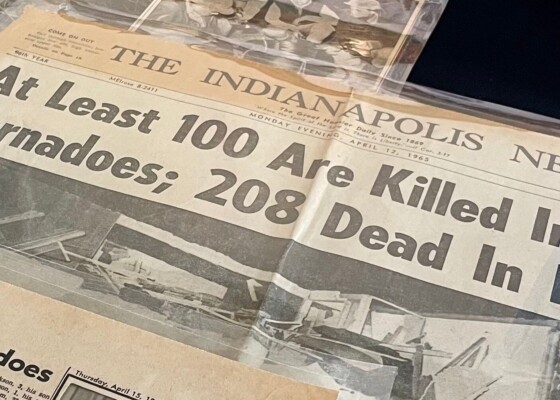Frankenstein Friday: Frankenstein at 200 and Beyond
November 30, 2018A few weeks ago, in an interesting and well-deserved shout out to all of our collective work with Indiana Humanities’ One State/One Story: Frankenstein, The New York Times called Indiana…
A few weeks ago, in an interesting and well-deserved shout out to all of our collective work with Indiana Humanities’ One State/One Story: Frankenstein, The New York Times called Indiana the “hell mouth” of the worldwide celebration of Frankenstein’s 200th birthday. I’ve been incredibly impressed by the intersectional community response I’ve encountered while traveling. It’s been so inspiring and fulfilling to collaborate on this excellent work and to connect–particularly so unexpectedly (Frankenstein, who’d have thunk?)– with so many creative, clever, curious Hoosiers.
I first read Frankenstein in a college lit survey course; I began teaching it as a grad student, and found it surprisingly emblematic of what I was learning defined my approach to teaching literature. Even then, though, it was never really about Frankenstein alone. Stitched and bound like Creature, the legacy of Frankenstein is a pastiche, an assemblage of texts across genre and time, its influence and meaning wonderfully polyphonic; and so, too, is this bicentennial celebration, the communities and conversations united similarly disparate, similarly multiple, similarly powerful, and, hopefully, similarly generative.
In the classroom, I’ve paired Shelley’s classic with Nathanial Hawthorne’s “Rappaccini’s Daughter,” Michael Crichton’s Jurassic Park, Ray Bradbury’s “A Sound of Thunder,” China Mieville’s Perdido Street Station, The X-Files episode “The Postmodern Prometheus,” Shelly Jackson’s hypertext “Patchwork Girl,” and an infinitude of other intertextual examples drawn across a sprawling, ever-growing family tree. When I teach a general education literature course, this general approach seems to hold true: I hope to instill the value of literary tradition, of reading “the greats” while, at the same time, stressing the importance of recognizing that there have always been other voices and perspectives. The courses I construct show students how a seminal writer like a Shakespeare, Sophocles, or Shelley may start a conversation, creating characters and laying out plot, but be far from the only participant in it. In providing students with groupings of literary and nonliterary texts or pairings of traditional classics and more popular texts, my courses work to reveal ‘Literature’ as an ongoing conversation in which my students’ reading and interpretation, too, plays a part. I love to demonstrate how becoming attuned to the ways in which stories respond to one another, across culture and chronology, allows us to better consider the centrality of story-telling to the human experience. In examining how stories change as they get told and retold form different cultural, socioeconomic, gender, and ethnic perspectives, we read for an understanding of how stories are not always from one perspective, one time, one culture, in a focus which allows us to understand how stories—and the meanings we make of them– are themselves fluid rather than fixed.
In part, I’ve viewed my mission as a teacher to lie in helping students truly connect with the lesson of Margaret Atwood’s “Happy Endings,” a short story which argues that plot is only “one thing after another, a what and a what and what” and that “How and Why” are, always, the more interesting questions. On their final exam, I’d have students contend with a passage from a novel they’ve never seen— Salman Rushdie’s Haroun and the Sea of Stories—in which they must recognize how stories are like an ocean, each “made up of a thousand and one different currents, each one a different color, weaving in and out like a liquid tapestry of breathtaking complexity” where “all the stories that had ever been told and many that were still in the process of being invented could be found…in fluid form,” with “the ability to change, to become new versions of themselves, to join up with other stories and so become yet other stories; so that unlike a library of books, the Ocean of the Streams of Story was much more than a storeroom of yarns. It was not dead, but alive.” For me, there is nothing more alive than the teaching of literature and the process of instructing students to read not only their fictions, but the cultural context of their own lives and the rhetorical constructions which order it critically and actively. One of my favorite opening-day classroom gimmicks projects a graphic of the alphabet, defamiliarizing the 26 letters and plying students with the combinatory puzzle of Umberto Eco’s potentially limiting assertion that “every story tells a story already told,” against The Never-Ending Story’s awed suggestion that “If you stop to think about it, you’ll have to admit that all the stories in the world consist essentially of twenty-six letters. The letters are always the same, only the arrangement varies. From letters words are formed, from words sentences, from sentences chapters, and from chapters stories.” This tension between the old and the new has always informed my fascination with literature and has come to define my philosophy as a teacher, as in my courses, in the texts and topics they unite and in the disparate students they bring together, there will always, ever, be more to explore. My teaching career has expressed these values (I hope), and my place within academy as well, as studying science fiction and fantasy has gained in prominence, as the traditional border guards are being sent home in favor of an increased focus on crossing boundaries between disciplines, approaches, and the academic/popular, making central what was formerly peripheral. The Indiana Humanities’ Speaker’s Bureau has been an incredible opportunity furthering these same goals, and it’s been inspiring to witness how beautifully and how organically the One State/One Story program and those participating in it have demonstrated these same principles.
Traveling the state, through toll-ways and cornfields, bringing the story into urban centers and small-towns, Frankenstein has never felt more rich, more vibrantly alive. In encountering communities all united together in collective celebration and exploration, watching thoughtful conversation between strangers flower about the meaning of a text, about the set of ideas it unleashes, I’m reminded how and why stories work, how and why literature remains such a powerful social force. It’s been immensely rewarding to be part of “the epicenter of American Franken-frenzy” this year (wow, such a quote!!), and it’s incredibly special for that epicenter to be yawing its maw so voraciously and generously here in Indiana! I had a blast exploring Mary Shelley’s legacy with folks from so many different perspectives. And, fittingly, my One State/One Story Frankenalia tour ended in a remarkably symbolic way.
After my very last lecture, two little boys came up, all bashful but proud and excited, to show me their notebooks full of art—lots of dinosaurs, some plesiosaurs and a megalodon shark, and lots and lots of scenes from Frankenstein, drawn from the mythic intertextual pastiche, the common cultural currency my lecture opens with. In ending my talk, I typically chose to close with a statement about what makes stories persist, and, in so doing, to shift the power back to the audience, to the communities taking time out to celebrate a text (and a genre’s!) 200th birthday. What happens when you all read it, when your libraries have reading groups to discuss it, when you chose to spend your time listening to me speak about it, and when we keep working on what we think things mean and what matters together? As I tell them, you’re all doing vital interpretive work right now; you’re keeping the story going, keeping it alive, making it new. You’re all part of 200; Frankenstein means what you think it does, the how and why of its persistence embodied in your presence, your participation. There will be no 400 without you.
One of these little boys had already blown my socks of when he chose to participate in the Q & A (I’d thought he was mostly there to color next to his mom so she could attend the lecture, though I’d caught him staring up, pitch-perfect, at all the most dramatic moments). “HOW does the scientist create life?” he’d asked (and I’d teased him, for making Victor and Shelley’s exact point about the danger and allure of such a question, and called him out for demonstrating exactly why these cautionary tales persist as texts that still have to hold wonder, and thanked him for the excellent discussion-mileage that got us); and then, later, a thoughtful follow up, “but WHY does he create it?” Even in the composition-rhetoric classroom, I spend the semester trying to teach college students to ask HOW and WHY of their texts. These are always the key questions, and these were this unexpected kiddos’. I loved meeting all the librarians and curators, the teachers and scholars, the medical professionals, the differently-abled, the racially and ethnically diverse, the neurodiverse, the genderqueer and the nonbinary who found points of identification in the text. I loved hearing from those with an encyclopedic knowledge of classic film, the fans of Bernie Wrightson, those who showed up in Jurassic World gear or with raptor keychains, those with pacemakers and other questions about AI and a world which chases science fiction. I even got to meet a paleontologist! But the wee ones who will outlast us all, the ones still many years away from entering my literature classroom, are surely extra special, too. Ending with these bright-eyed little boys jostling for favor at my knees, brimming over with excitement and pride and curiosity, was quite a remarkable finale, and a pretty incredible taste of the future. Frankenstein, at least, is in good hands. Here’s to the next celebration!

